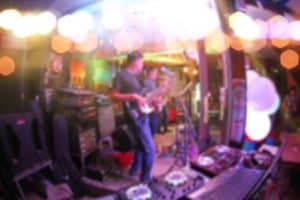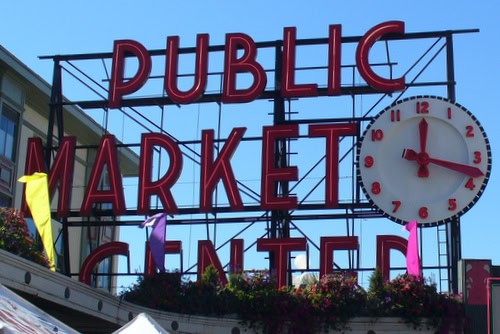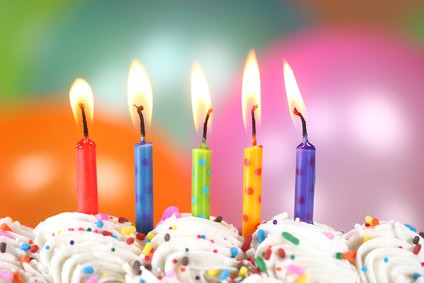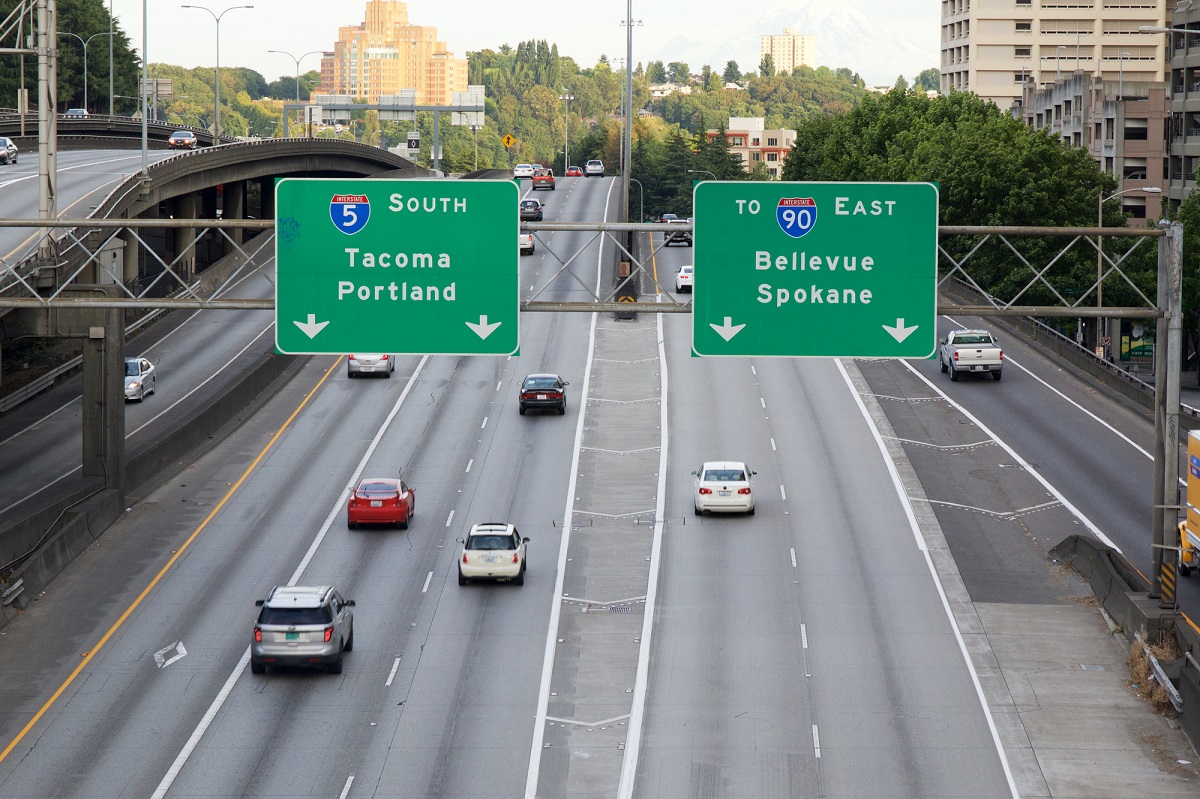Bookmark this page for quick access to resources for emergency preparedness in Seattle and the Puget Sound region. These resources can help you get prepared before an emergency occurs and after disaster strikes.
This emergency preparedness information includes links to local and national emergency preparedness resources containing helpful information for developing an emergency plan, a checklist for creating a plan including disaster kits and “go” bags, and other information to help you prepare for floods, stormy weather, earthquakes, and other potential disasters in the Puget Sound region.
In addition, any upcoming free training, workshops, or community events about emergency preparedness are listed in the calendar at the end of the article.
Love our cheap ideas? Get our FREE email newsletters.
Choose from daily, weekly, and monthly lists:
Are you ready for winter?
Remember Snowmageddon? Thankfully, we don’t see snow every winter in the Pacific Northwest. But we often see heavy rains, freezing temperatures, and high winds. Whatever Mother Nature might choose to throw at us, get yourself, your family and your home ready now. Preparedness can be as easy as following a checklist. Here are some easy-to-follow steps, created by King County support your personal winter preparedness.
- Freezing Temps & Snow Checklist
- High Winds Checklist
- Heavy Rains Checklist
- Home Maintenance Checklist
- Winter Weather Driving Checklist
To see these checklists in additional languages, visit takewinterbystorm.org/checklists.
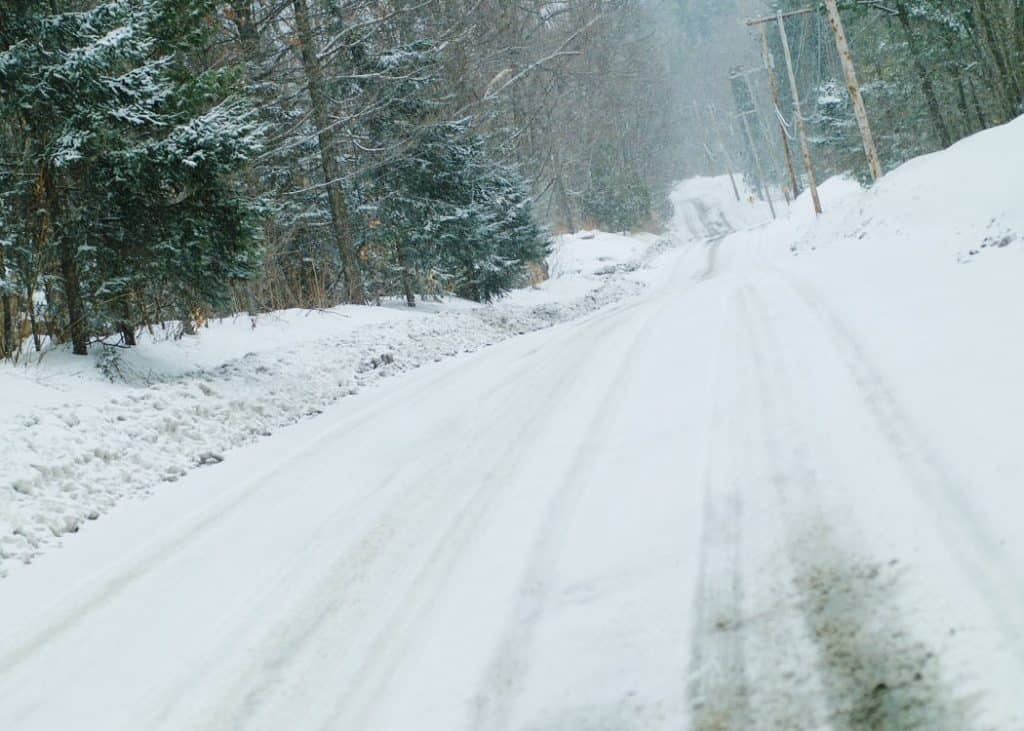
Be prepared! Use these King County checklists to prepare for winter weather.
Emergency Preparedness Resources
Seattle and King County Emergency Resources
The following resources can help residents of Seattle and King County prepare for or get help after emergencies and natural disasters.
King County Emergency Management Preparedness provides planning for King County families, businesses, and communities to prepare and survive disasters, everything from an earthquake to a major winter storm.
Seattle.gov Emergency Management offers resources in several languages about how to prepare for emergencies for your family, your home, or in the workplace. There are also links to training resources.
AlertSeattle is the official emergency notification system used by the City of Seattle to communicate with city residents during emergencies. Get more information and sign up to receive free alerts from the City via text message, email, voice message or social media.
Get emergency alerts in the Puget Sound region. We list several emergency notification systems throughout the Puget Sound region. These public alert systems are a free service. The systems are used to send alerts to the public, first responders, and other government employees. Sign-up online to receive emergency alerts via any of several methods, including text, email, voice message, or social media.
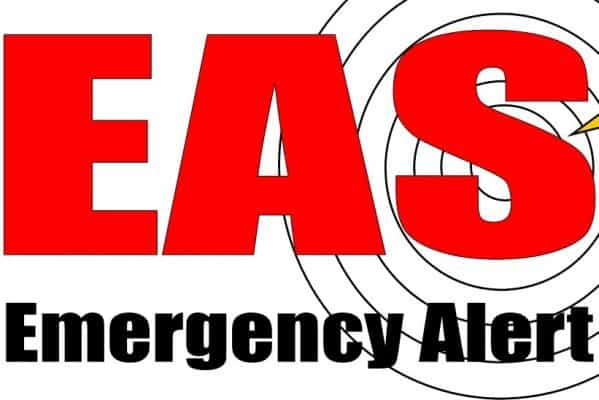
Washington State emergency resources
The following resources can help anyone in Washington State prepare for or get help after emergencies and natural disasters.
Washington State Department of Health ‘Be Prepared Be Safe’ offers planning tips with actionable steps you and your family can take before, during and after an emergency or hazard.
Washington State Military Department, Emergency Management Division offers a plan to build your emergency kits over the course of a year, plus links to Emergency Alert System (EAS) in your county, and other helpful resources.
Washington State Department of Natural Resources (DNR) has general information on how to prepare for emergencies and natural disasters possible for Washington State residents.
Ready.gov/washington lists common hazards in our state and local/city emergency office contact information across Washington State.
The Mountaineers Ten Essentials list first appeared in the third edition of the book Mountaineering: The Freedom of the Hills, released in 1974 by Mountaineers Books. The list dates to their climbing courses in the 1930s, and the purpose has always been to answer two basic questions: can you respond positively to an accident or emergency and can you safely spend a night (or more) outside. For many emergency situation in the city, some of the ten essentials are not necessarily useful. Regardless, it is a useful list to consider for you emergency kit. Here are some considerations:
- Many of the 10 essentials are in a typical suggested Emergency Kit supply list: food, water, clothing, tools, light, and first aid.
- The Mountaineers list assumes you are in the wilderness, therefore other essentials include navigation (compass, etc.), sun protection (hat, lotion), fire (matches, lighter), and shelter. These items may or may not be useful in your Emergency Kit. But they might, such as if you live in a remote area or bike to work.
- The 10 essentials list is often adapted for other situations, such as day hikes versus long treks, warm versus cold weather, water excursions, trips including small children, and other situations.
- The essentials list is also published by organizations such as the National Park Service, Cub Scouts and Boy Scouts of America, Washington Trails Association, and REI.
National emergency resources
These national sites offer emergency planning and assistance mostly covered by local agencies above. However, they are worth a quick review.
Make a plan at Ready.gov. Your family may not be together if a disaster strikes. So, it is important to know which types of disasters could affect your area and plan how you’ll reconnect if separated. This checklist helps you develop a plan for your family situation. There are also several downloadable plans for different situations such as kids, pets, and first aid kits.
Ready.gov/alerts describes different warning alerts you can receive and the types of devices that receive the alerts, including Emergency Alert System (EAS), NOAA Weather Radio, and other resources.
National Weather Service (NWS) offers Severe Weather Alerts through official sources, including NOAA Weather Radio, NOAA Weather Wire Service, and Weather.gov.
American Red Cross has developed emergency-specific checklists using the latest research, best practices and expert opinion. Start with this easy preparedness plan to help you prepare for any type of emergency.
Emergency Preparedness Plans
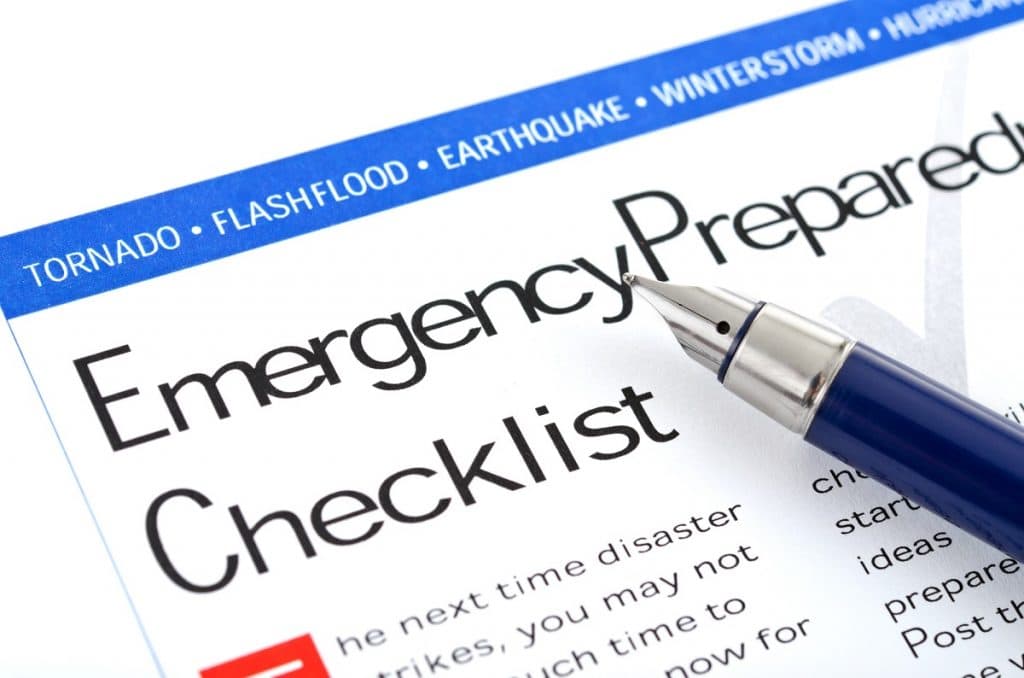
To help you get started, here are the basic steps you need to complete in order to develop an emergency preparedness plan. Experts tell us not to do it all at once, rather over time, even taking up to one year. The first time I got my plan and supplies together, it took several months. But I’m due for a review and re-supply.
- Create a family emergency plan: where to go, what to do, and how to reconnect.
- Know your evacuation routes (in case of fire, flood, earthquake, etc.).
- Include a pet emergency plan if needed, such as when you need to go to a shelter where pets are not accepted.
- Create one or more emergency kits.
Emergency Kits
It’s recommended to pack emergency supplies into one or more emergency kits. For example, you might have a 3-day evacuation supply for yourself in a “go” or “ditty” bag in the car or office (or both), and a 2-week supply at home for every member of your household.
This is by no means a complete list, rather a suggested list to get you started. Review the above resources and adapt the list to suit your family needs and living situation.
Be sure to review and replenish your kit once or twice a year. It’s not a one and done task. Daylight savings time is easy to remember (March and November), when you are also changing the batteries in your home smoke detectors. Or make emergency kit supplies a family activity to review around the holidays and before summer vacations.
Emergency Kit supplies to replenish every 6 to 12 months
These items are more perishable than other emergency kit supplies, so need to be checked and replenished regularly. I find it easiest to simply rotate these supplies any time I need to buy a household product, by replenishing the emergency kit first and rotating kit items to the household supply.
- Water: one gallon per person (and pet), per day. Half of the supply can be for non-drinking purposes, such as washing and toilets, by filling large (5 gallon) containers from the garden hose. Commercially bottled water is best for drinking water. Replace before the water expires, or every 6 to 12 months.
- Food (non-perishable, no cook, or easy-to-prepare items), such as: ready-to-eat canned meats, fish, beans, soup, stew, fruits, and vegetables. Be sure to add a can opener to your kit. Other types of useful products include protein bars, dry cereal or granola with nuts and dried fruit, peanut butter, dried fruit, and canned or boxed milk. Don’t forget pet foods or family members with special dietary needs, including infants. Tips: buy foods you already eat and that your family likes. Check expiration dates and replace before foods expire.
- First aid kit: you can buy first aid kits at most drugstores or outdoor recreation stores, or simply assemble supplies on your own. I’ve done a little of both. When I need to replenish supplies, I’ll combine what I have into one kit and add missing supplies or purchase a whole new kit, depending on how much is needed.
- Medications should be part of your emergency kit for you or any family member who requires a prescription or regular medical care.
- Personal hygiene items, including: travel size toothbrush and toothpaste, travel size shampoo, hand/body wipes or towelettes, deodorant, razor and shaving cream for men, and sanitary napkins or tampons for women. Sanitary napkins can also be used for first aid to control bleeding.
- Batteries for any item in your kit, such as a flashlight or radio.
- Miscellaneous supplies: A small bottle of bleach and zipper style and/or plastic trash bags.
Emergency Kit items to review and replace as needed
These items don’t expire, but should be replaced if they become inoperable or your needs or family information changes.
- Flashlight, battery-powered or hand-crank, and/or light sticks
- Radio (preferably a NOAA Weather Radio), battery-powered or hand-crank
- Multi-purpose tool (such as Leatherman or Swiss Army multi-tool)
- Cell phone with charger
- Portable toilet (bucket, plastic bags, toilet paper)
- Copies of important documents, such as medication list, medical information, proof of address, deed/lease to home, passports, birth certificates, or insurance policies
- Family and emergency contact information
- Extra cash (small bills: $1, $5, or $10)
- Emergency blanket, hand warmers
- Extra clothes, per person (such as sweat pants, hoodie, underwear, socks, and shoes)
- Maps of the area
Ham Radio and Personal Radio Service
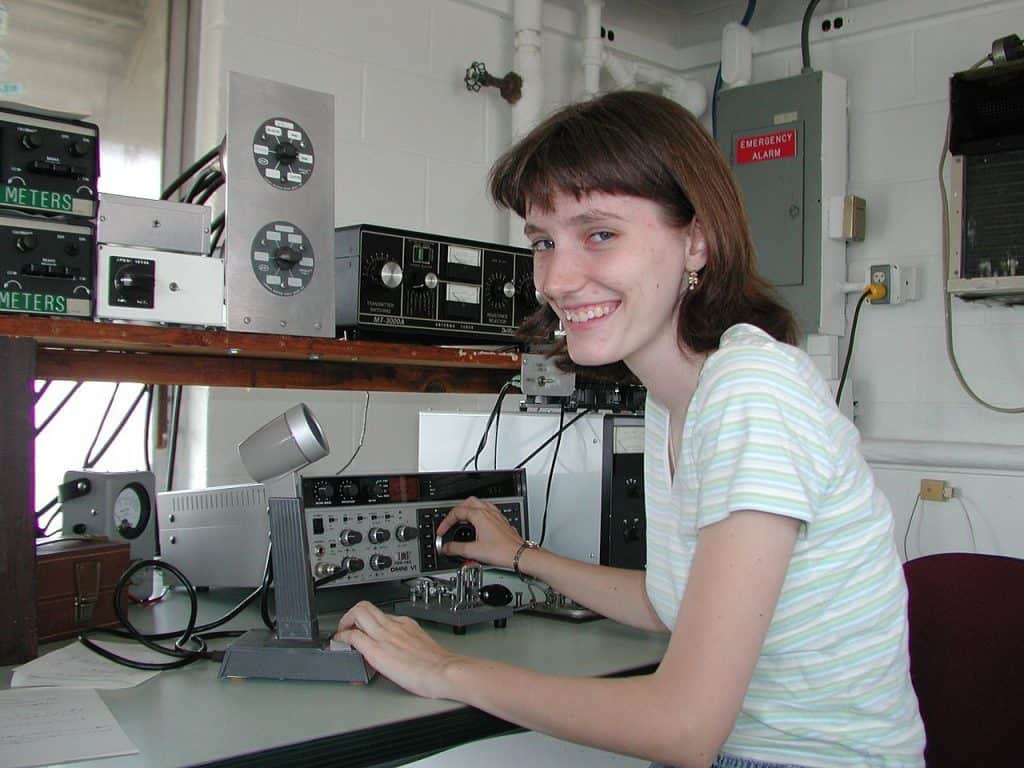
Amateur ‘ham’ radio operator, Yvette Cendes, KB3HTS, at station W8EDU, 2005. Photo by Andromeda321 at en.wikipedia (Yvette Cendes) (CC3)
Amateur or non-commercial radio (aka HAM* radio) is a method of two-way communication using certain radio frequencies. HAM radio can be used to talk across town, around the world, as well as to satellites in space, without using phone lines, cell phones, or the Internet.
People use ham radio for a variety of reasons: to exchange messages, to experiment with technology, just plain fun, or to communicate during emergencies. It is a viable alternative in the event of a disaster that disables other communication methods. In fact, ham operators have often been a vital resource for civil agencies during large scale disasters such as earthquakes and hurricanes.
Radio transmission is regulated in the United States by the Federal Communication Commission (FCC). This is necessary to assign frequencies to different groups; otherwise it would be like everyone talking at once.
To operate a two-way ham radio you need to get a license. To get a license, you need to pass a test that asserts you know the rules for transmitting and have the necessary radio knowledge. To pass a test, you need to study. There are free online study materials, library books, and ham radio study classes. If you wish, you can purchase the ARRL Licensing Manual for around $30. The license testing fee is $15.
Once you have your license, the cost of a communication radio begins around $40 for a handheld transceiver. Of course, depending on your needs and interests, you can spend upwards of $200.
For more information, visit the National Association for Amateur Radio (ARRL) and/or find a ham class near you.
*Why is it called HAM? There are numerous stories: the names of inventors of radio technology, the first amateur radio station call sign, the “Home Amateur Mechanic” magazine (never existed), and a derogatory term used to describe someone with poor Morse code skills. When you follow these stories to factual data of the period, there is no tangible evidence to support it. There is an example of the use of “hams” in the story “Floods and Wireless” in the August 1915 edition of Technical World Magazine. However, the use of the term is not explained. The consensus given by ARRL is that amateur radio enthusiasts in the early 1900s liked to jam the radio frequencies for military and commercial operations, who referred to the interlopers as “hams”–a reference to their excessive theatrics, as an actor who “hams” it up, rather than a lack of expertise. On the contrary, early hams, then as now, were important resources in times of critical communication needs.
Personal Radio Service
There are other two-way radio communication devices that do not require a license, but are still regulated by the FCC. Examples include CB radios and walkie-talkies. Depending on your emergency needs, these types of short range, lower power personal radio services might serve your emergency communication needs at a lower cost.
Other Preparedness Classes
Here are some other places to find emergency preparedness training:
- Government agencies sometimes hold free training classes in emergency preparedness, especially in fall for “National Preparedness Month” in September.
- Red Cross offers paid training throughout the year.
- You can also check the Seattle emergency preparedness training calendar.
Event calendar of free and affordable things to do
Listed below are all types of free and affordable things to do in the next 30 days.
Featured Events are listed first each day, highlighted by a photo. These are unique, popular, or annual events that we or our advertisers don’t want you to overlook.
Find more events and ideas for affordable living at Greater Seattle on the Cheap – Free things to do, cheap fun, discounts and deals in the Seattle-Tacoma metro area


